
2021. It was the best of times; it was the worst of times. Rather, it was a year marked by unforeseen opportunities and quite a few accompanying challenges – such as the global chip shortage and the largest imbalance between supply and demand that the semiconductor industry has ever witnessed.
Successfully leading a company under normal circumstances is already quite a feat. However, assuming leadership of a global business, with responsibility for thousands of employees, during a pandemic and climate crisis – that’s a challenge of another level. Fortunately, Kate Wilson, president of the semiconductor division at Edwards Vacuum, has been preparing for challenges her entire career – and she’s already made progress in tackling critical issues like reducing Edwards’ carbon footprint, building an inclusive workplace, and contributing to overcoming the global chip shortage. Following her presentation at the Executive Forum during SEMICON Europa, Cassandra Melvin of SEMI Europe spoke with Kate Wilson about these topics and more.
Melvin: What has been at the top of Edwards Vacuum’ strategic agenda throughout your first year as President of the Semiconductor division?
Wilson: 2021 has been a challenging year. The semiconductor industry has seen unprecedented demand as the pandemic has continued to disrupt many aspects of our personal and business lives. Our primary focus at Edwards Vacuum has been maintaining the stability and agility we need to ramp our production capacity to meet the needs of our customers, now and in the future.
 The surge in demand and production has also brought into clearer focus the environmental impacts of our industry, semiconductor manufacturing, and heightened our sense of urgency to find solutions that will reduce our, and our customers’, carbon footprints. A critical component of our strategy is an intentional effort to develop a more diverse and inclusive work environment, which will allow us to be more innovative and responsive to the needs of our customers, our employees, our financial stakeholders, and the global community.
The surge in demand and production has also brought into clearer focus the environmental impacts of our industry, semiconductor manufacturing, and heightened our sense of urgency to find solutions that will reduce our, and our customers’, carbon footprints. A critical component of our strategy is an intentional effort to develop a more diverse and inclusive work environment, which will allow us to be more innovative and responsive to the needs of our customers, our employees, our financial stakeholders, and the global community.
On the environmental front, as part of the Atlas Copco group we have recently joined the Science Based Targets initiative (SBTi), which provides companies like ours with a clearly-defined path to reduce emissions in line with the Paris Agreement goals – limiting global warming to well-below 2°C above pre-industrial levels and pursuing efforts to limit warming to 1.5°C. The framework covers those areas directly owned – in Edwards’s case, that means our own operations – as well as indirect areas over which we have some level of control or influence.
Indirect areas include both upstream contributions – such as energy sourcing, the transportation of materials into our operations, business travel, and employee commuting; and downstream – what we do to help our customers reduce their carbon footprints, such as reducing the energy consumed by our products and removing PFCs from our customers’ exhausts. In 2020, Edwards Vacuum abatement systems prevented the equivalent of 17.7 million tons of CO2 emissions at our customers’ facilities – equal to the combined annual emissions of the cities of Madrid and Milan.
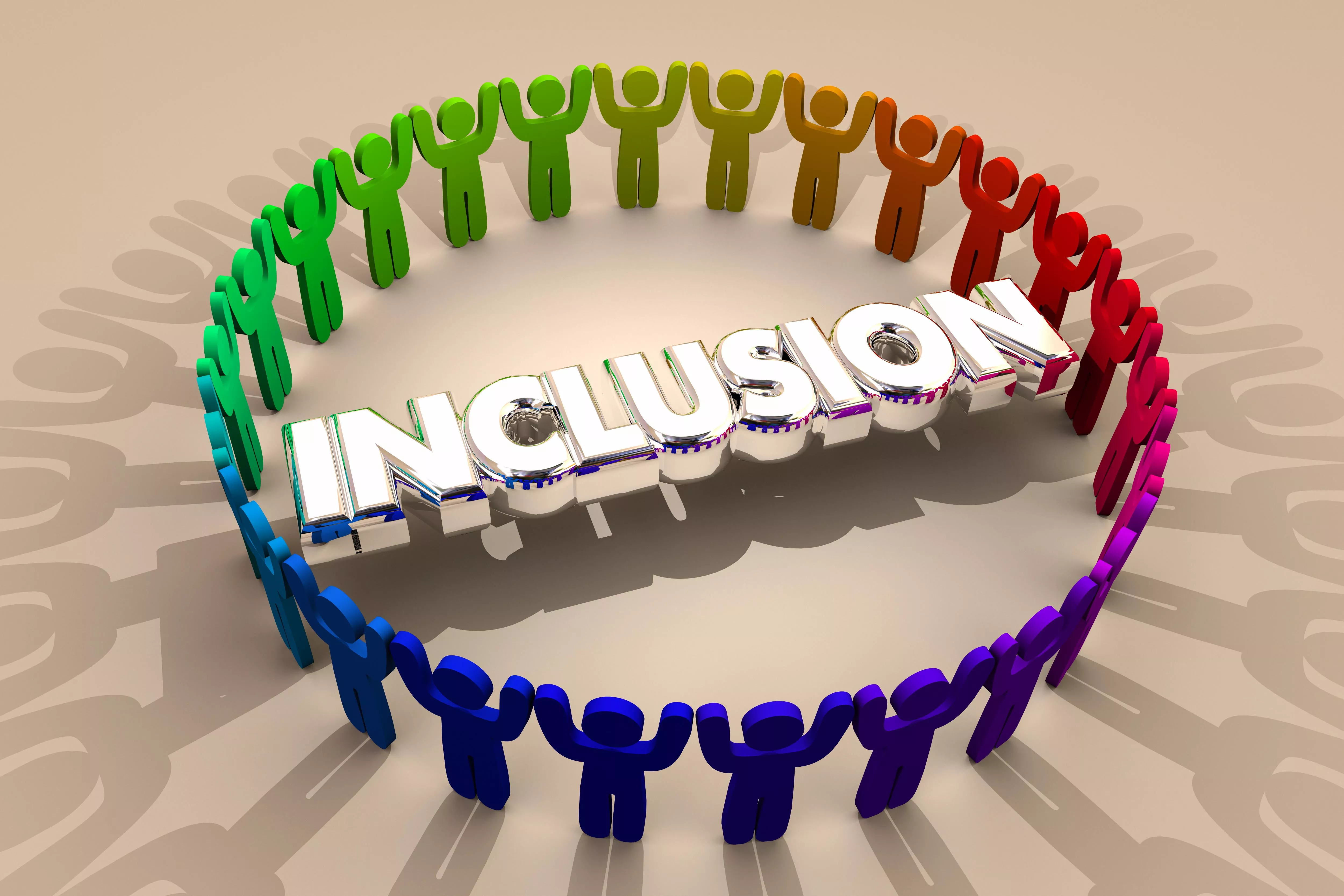 We have also made substantial progress on diversity and inclusion. We have focused firstly on gender diversity and showed a steady increase in diversity over the last few years, but we are also looking at diversity on a much broader scale. It is important to point out that our commitment to increasing diversity comes from our firm belief that finding the best solutions to the challenges that we and our customers face depends critically on having more voices at the table, more people looking from different perspectives, and ultimately, a more diverse set of ideas and possible solutions to consider.
We have also made substantial progress on diversity and inclusion. We have focused firstly on gender diversity and showed a steady increase in diversity over the last few years, but we are also looking at diversity on a much broader scale. It is important to point out that our commitment to increasing diversity comes from our firm belief that finding the best solutions to the challenges that we and our customers face depends critically on having more voices at the table, more people looking from different perspectives, and ultimately, a more diverse set of ideas and possible solutions to consider.
Melvin: That’s an interesting point to highlight – the role of diversity in providing the best solutions to your customer’s challenges. Can you elaborate on that?
Wilson: To get the best ideas and the best innovation you need different ideas and different points of view. It’s a non-linear effect. Diversity feeds on itself. Diverse ideas stimulate others who hear them to think more broadly and creatively. None of our solutions today are linear. It’s not, “Oh, let’s just do this little bit better.” That low-hanging fruit was picked long ago. We must look at completely different types of solutions to get through the really difficult problems. Without diversity we’ll all just keep doing the same things over and over. We won’t get to the innovative and step-change solutions that we need.
Inclusion is a key part of diversity. You may build a more diverse workforce but without inclusion, without making everyone feel welcome, valued, and free to contribute, you won’t realize the benefits of diversity. Inclusion gets you the best of everybody. Inclusion drives that breadth of innovation and contribution from people. So not only do you want more people with more diversity, you must also listen to every voice.
Melvin: Can you share an example from 2021 of how diversity enabled the Edwards Vacuum team to be more innovative?
Wilson: I consider collaboration with customers to be an extension of diversity and inclusion. Collaborating with customers and other stakeholders adds another set of diverse viewpoints to any problem-solving effort. Including customers in the process not only improves the fit of the eventual solution. It also encourages respectful relationships that value the diverse contributions of everyone involved. Collaboration can open your eyes to possibilities you might otherwise dismiss.

For example, one idea we have looked at is shared pumping. Our initial reaction was to dismiss it because our customers would never accept it. But when we started talking to a diverse audience, we found real interest in at least exploring the possibilities. You can shift your thinking and theirs and build acceptance for innovative solutions because you are having a conversation with a broader set of people.
Melvin: Throughout the pandemic, has there been a significant shift in how the Edwards Vacuum team supports its customers?
Wilson: We have always supported our customers locally, but during the pandemic we have had to accelerate the development of our local teams. Online training and staying connected to customers virtually became much more important. We found that we had more contact with customers and deeper contacts throughout their organization. It has also allowed more contact between our factory engineers and our customers, with tremendous benefits in both directions.
And our training became more effective and efficient because employees didn’t have to wait for physical training locally – they could complete their training as needed and as permitted by their other responsibilities. It is going to be great to get back to face-to-face, but we will continue use everything we’ve learned during Covid to maintain better connections with our customers and within the organization.
Melvin: At the Executive Forum, you highlighted that a holistic approach to carbon neutrality should extend along the supply, manufacturing, and distribution chain. How is Edwards paving the way to carbon neutrality, within its own supply, manufacturing, and distribution chains?
Wilson: I often say pictures say more than a thousand words, and in four images, I can showcase what we are looking to do as a business.
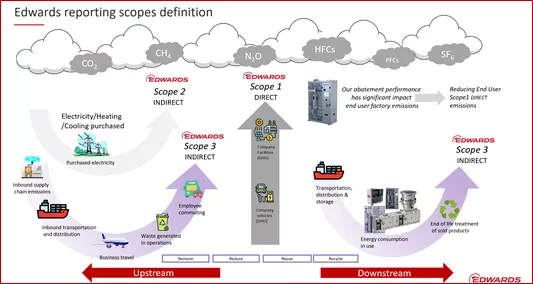
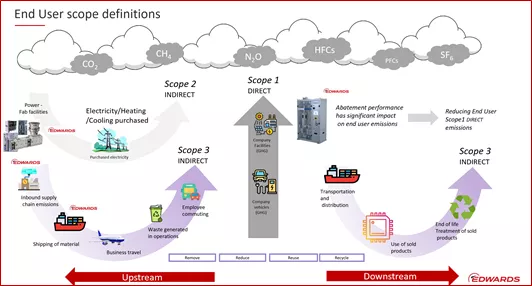
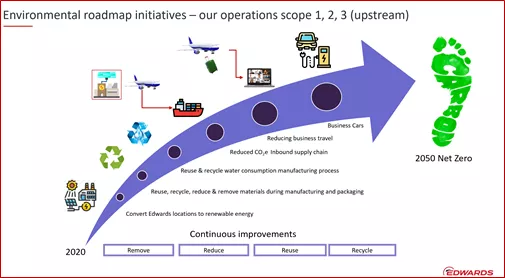
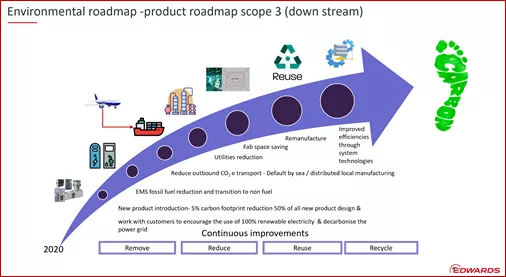
Melvin: Considering the thriving career you’ve led thus far, how has the role of diversity and inclusion within organizations, and within the industry, evolved over the past few decades?
Wilson: Gender diversity has always been a problem and it continues to be. We do need to fix the problem of the underrepresentation of women in the chip industry workforce. Put quite simply, if you exclude half the population from the talent pool, you have excluded half of the best talent. But really diversity isn’t about that, it’s about different ideas and different ways of thinking and different approaches to problem-solving so that we can actually get to the best solutions.
Gender diversity is an obvious example, but it isn’t really a very good representation of the broader diversity problem. The diversity problem is if you don’t have a broad set of ideas and perspectives, you’re not going to get the best solutions. If you don’t look at everyone for talent, you are not going to get the best talent, and you are not going to drive the industry forward as quickly as we want to.
Melvin: Leadership – in the era of a chip shortage, industry-wide talent crisis, and global pandemic – certainly looks different than in the past. Do you think there has been a paradigm shift with regards to leadership in general, and specifically with how semiconductor industry executives lead?
 Wilson: I do think there is a bigger focus on people than in the past. Mainly for business reasons because we can’t get enough people. It’s one of the biggest challenges for the industry, finding and keeping the talent we need. I also see more emphasis on well-being and quality of work life. Corporate social responsibility initiatives have brought more visibility to these issues.
Wilson: I do think there is a bigger focus on people than in the past. Mainly for business reasons because we can’t get enough people. It’s one of the biggest challenges for the industry, finding and keeping the talent we need. I also see more emphasis on well-being and quality of work life. Corporate social responsibility initiatives have brought more visibility to these issues.
The recent surge in chip demand and the COVID-19 pandemic have taught us a lot about sustainable operations and business continuity, and then there's the increasingly urgent need to respond to environmental issues – we can learn a lot of lessons from the past two years to help us in the future.
Melvin: Throughout the pandemic, more leaders have spoken up about well-being and the importance of fostering positive mental health in the workplace. What is Edwards Vacuum doing as an organization to promote employee well-being?
Wilson: We have a broad program to look at overall well-being, which includes mental health. It’s really about people’s attitudes about work. We have a framework that addresses physical health, mental health, well-being, and social connectedness. We’ve always had programs in these areas, but this brings them together in a holistic view. It includes components like mental health training for managers so they are more aware and looking for signs of health issues and can encourage colleagues to get more help when they need it. Of course, the pandemic has magnified the need for these programs.
Melvin: Acknowledging employee well-being challenges is a critical component of building an inclusive workplace. Inclusion is defined by SEMI as authentically valuing, leveraging, and welcoming individuals with different identities, thoughts, and beliefs within a given setting, and intentionally creating a sense of belonging amongst all. Can you provide a few examples of what Edwards Vacuum has done from an organizational point of view, and from the bottom up (employee-led), to create a more inclusive workplace?
Wilson: There are lots of little examples, but they all add up. We celebrate all the minority days. We make sure to educate people on what inclusion is, help them learn how to talk to people, what to do to include people. We try to help managers and colleagues understand that it is their responsibility to talk to people and include them. Even within meetings, especially virtual meetings, we must let everybody on the call know and feel that they are valued and encouraged to speak.
A lot of people are a little scared of minorities and inclusion because they don’t know what to do or say or don’t understand what inclusion means. So, one big focus is on education, what it means, how to talk about it. Understanding unconscious bias. Making people aware that we all have unconscious bias, because lots of people don’t think they do. We have started networks driven by employees who want stronger connections with minority groups. The first of these is Fusion, a network for the LGBTQ+ community.
Melvin: Is there anything else you’d like to note on DE&I and sustainability, and where can we direct readers to learn more about the initiatives you’ve mentioned today?
Wilson: We have shown as an industry that when we work together, we are a powerful force for good. Extensive collaboration has always been at the heart of our past successes. Moving forward I am confident that very same history of collaboration will drive our success in DE&I and sustainability.
Edwards Vacuum is a SEMI Europe DE&I sponsor this year.
Learn more about Edwards Vacuum commitment to diversity and corporate responsibility.
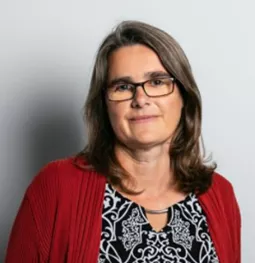 Kate Wilson, president of the semiconductor division at Edwards Vacuum, has more than 25 years’ experience in vacuum management solutions for the global semiconductor industry. Wilson has held various strategic roles since joining the Edwards Vacuum graduate scheme in 1994.
Kate Wilson, president of the semiconductor division at Edwards Vacuum, has more than 25 years’ experience in vacuum management solutions for the global semiconductor industry. Wilson has held various strategic roles since joining the Edwards Vacuum graduate scheme in 1994.
More recently Wilson was the VP Marketing Subfab Solutions for Edwards’ global Semiconductor business until January 2021 where she took over the role of president of the Semiconductor Division (Subfab). Wilson is a passionate ambassador for diversity and inclusion both within the organization, and in the wider semiconductor and engineering sectors. Wilson holds a BEng in Mechanical Engineering from Brunel University in the UK.
Cassandra Melvin is Director of Operations and Business Development at SEMI Europe.